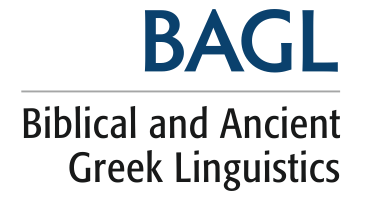
Volume 6 (2017)
Show
table of contents
6.1 | Geneva College, Beaver Falls, PA, USA A common closed-class feature of languages, prepositions connote spatial and
logical relationships, often (though not always) preceding the noun to which they
specify that relationship. Their use is highly idiomatic to a given language, such
that their meaning may be best connoted by something other than a general
translation equivalent. It is widely theorized that case-marking historically
preceded the rise of prepositions, though in Hellenistic Greek (as in earlier forms
of English) these have been employed simultaneously. Cross-linguistic consideration
of this basic feature of language can be a helpful step toward understanding the
role of prepositions in the Greek of the New Testament. (Article) Keywords: Greek, ad/pre-positions, cross-linguistic, diachronic,
mono/poly-semy |
6.2 | McMaster Divinity College, Hamilton, ON, Canada Greek prepositions belong to a class of words that are usually called
particles. These function words are morphologically invariable and enable their
function by indicating some kind of relationship between larger units. This means
that prepositions are part of a larger category of words that include not only
prepositions but conjunctions, adverbs, and possibly other lexemes. Systemic
Functional Linguistics does not have an explicit theory of the preposition. However,
prepositions are important within both syntagmatic and paradigmatic structure, and
function at various ranks and as components of various structures at those ranks. In
this paper, I discuss five topics regarding prepositions: word groups and phrases,
types of prepositions, prepositions and other relators, the meaning of prepositions,
and the function of prepositional groups within SFL architecture.
(Article) Keywords: Preposition, Greek, Systemic Functional Linguistics, conjunction,
adverb |
6.3 | Semitic Influence in the Use of New Testament Greek Prepositions: The Case of the
Book of Revelation Adventist Theological Institute, Cernica, Romania Semitic influence on New Testament Greek prepositional use has been proposed
by various scholars.At times, it turns out that the examples these scholars
emphasize are quite unconvincing, many times because their methodologies seem
unclear. This article proposes the use of the Second Language Acquisition approach
in assessing the degree of Semitic influence on the New Testament Greek prepositions
uses and applies it in the case of the prepositional irregularities found in the
book of Revelation. Error Analysis is a method whereby the source of a linguistic
irregularity is identified and the irregularity is explained. The question of this
research is, what is the source of Revelation’s prepositional irregularities? The
paper discusses the usage of prepositions such as εἰς, ἐν, ἐκ, µετά, ἀπό, and ἐπί in
the book of Revelation, the New Testament, and the Greek language at large. Unclear
terminology and inaccurate methodology are two factors that led to the conclusion
that the source of the irregular prepositional use in Revelation is mainly Semitic.
This paper uses the terminology of Second LanguageAcquisition and its findings drawn
from empirical studies about linguistic transfer and facilitation from the mother
tongue into the second language. In light of Second Language Acquisition, there seem
to be strong arguments thatconfirmtheGreekhypothesisandinformtheSemiticexplanation
for virtually all of John’s peculiar prepositions. (Article) Keywords: Prepositions, Greek, Semitic influence, second language acquisition,
Revelation |
6.4 | Pacific Institute of Languages, Arts, and Translation Ukarumpa, Eastern
Highlands Province, Papua New Guinea Relevance Theory offers historical-grammatical interpretation a model of human
communication that aids in clarifying the reason modern audiences inappropriately
apply their own context to a biblical text. Hill’s matrix, drawing on the model
proposed by Relevance Theory, is a tool allowing expositors to explore the
inappropriate context readers apply to the biblical text. Hill’s matrix can aid
interpreters in the discernment of assumptions as appropriate or inappropriate to
apply to a text in a search for authorial meaning. Applying Hill’s matrix to Acts
12:15 an exegete can identify both inappropriate assumptions modern American readers
bring to the text as well as those contextual assumptions needed to find authorial
meaning which are missing from modern readers’ context. Keywords: Acts 12, historical-grammatical, New Testament backgrounds, interpretation,
Relevance Theory, angel, communication theory. |
6.5 | McMaster Divinity College, Hamilton, ON, Canada This review article critically engages two recent monographs that utilize
Charles Ruhl’s theory of monosemy to analyze the New Testament. After outlining
Ruhl’s theory, I discuss how Gregory Fewster attempts to model monosemy within the
linguistic framework of Systemic Functional Linguistics, and how Benjamin Lappenga
does so within the framework of Relevance Theory. Each makes important
contributions, but I argue that neither has significantly improved on Ruhl’s
original model and that some of the modifications of Ruhl’s theory end up being
unhelpful or unclear. Nevertheless, both authors have persuasively exhibited the
usefulness of a monosemic approach to studying biblical words and texts. Keywords: Monosemy, Gregory P. Fewster, Benjamin J. Lappenga, Charles Ruhl, Lexical
Semantics |
6.6 | McMaster Divinity College, Hamilton, ON, Canada Arizona Christian University, Phoenix, AZ, USA This article responds to the article by Madison Pierce and Benjamin Reynolds
on the use of the perfect tense-form in John 3:13. While we commend their treatment
of verbal aspect in their analysis, we offer several points of correction on several
issues, including the semantics of the perfect tense-form, the use of the aorist
participle, and the conditional clause. Keywords: Greek tense-form, perfect tense-form, stative aspect, aorist articular
participle, conditional clause |
Articles are in PDF format that can be read with Adobe Acrobat Reader (download) and will open in a new window